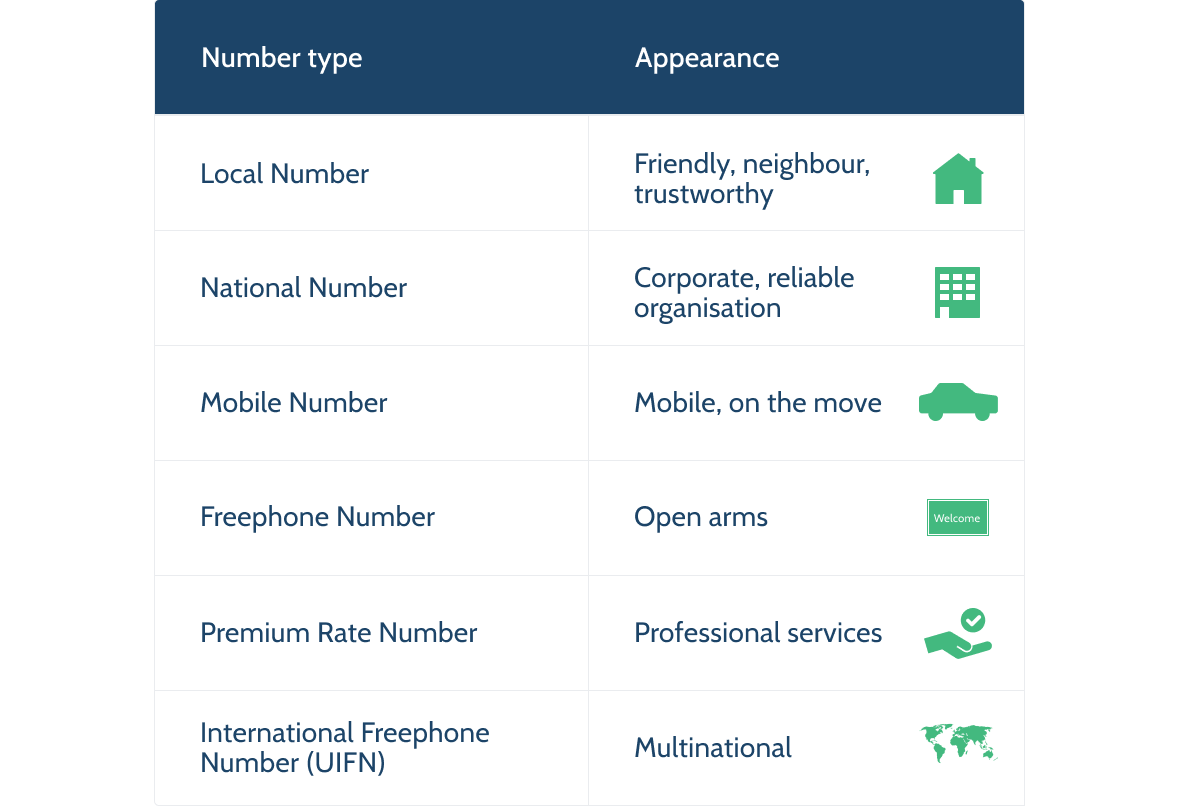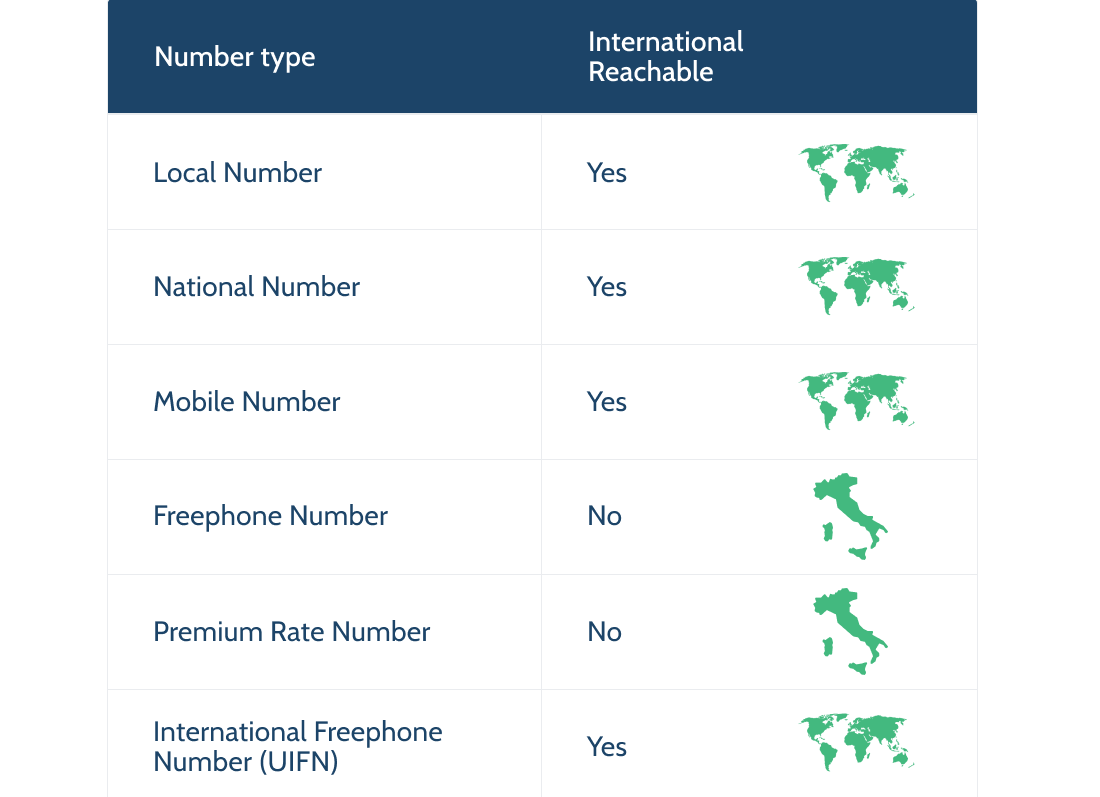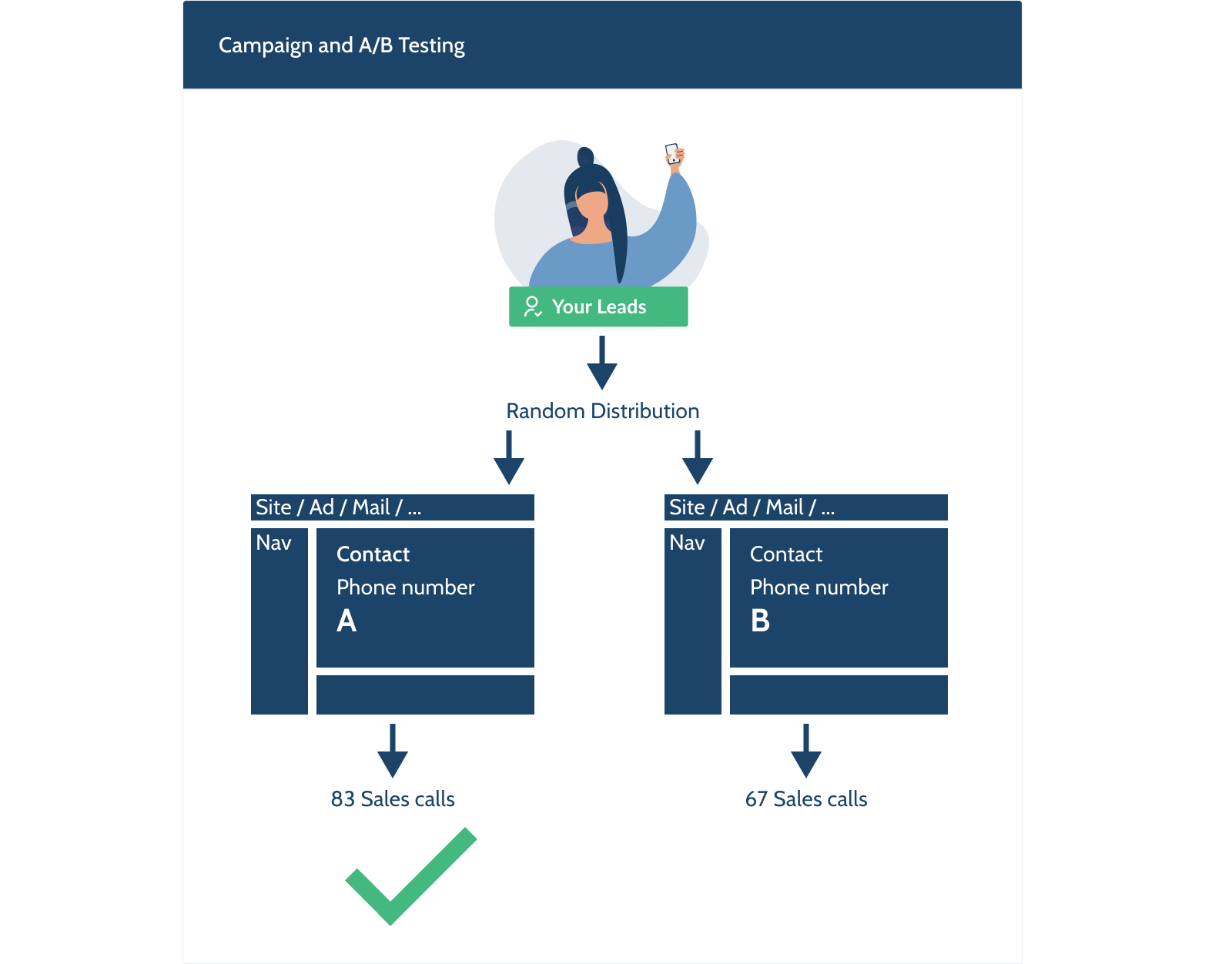Phone Numbers For Web Designers
It is exciting how websites are being optimized. Localization, A/B testing, and cross-domain campaign tracking contribute to your bottom line. But why stop there? The customer experience is not determined by your website alone. Take the next step and start to include your telephony in the optimization span. And it is a relatively easy step to take as you are already familiar with the mechanisms. Simply follow these seven considerations.
First Things First: The BasicsBefore determining which number type to use and when and how to present them on your website, it helps to know which number types are available, to begin with:

Each of these numbers can be valid to use, depending on your strategy. It is important to line up the localization, appearance (tone of voice), and other factors of your website and the phone number type you choose. And — like your website — keep testing and optimizing your choice.
Let’s dive into the details of the seven considerations to make.
LocalizationA lot has been written about localization. Why it is important and how to achieve it with your website. All this attention is leading to great results. However, a website and the product are not the only points of contact with the customer and do not fully cover the customer experience domain. So, there is much to be gained here.
The localization of your website and phone number choice needs to be in sync. If your website is tailored per country, the phone number should also be country-specific. It would be weird to have a site for a specific country but not a phone number. And the beauty is that you have already determined the level of localization required for your website. You can simply match the localization needed to the available phone number types.

If your website localization is country-based, then get one of these numbers:
- National number,
- Freephone number,
- Premium Rate number.
All of these are suitable for country-wide operating businesses. We’ll get back to how to choose which one fits your case best later in this article.
If your website targets specific areas smaller than a country:
Get local numbers in the same areas you are targeting with your website. It strengthens your website localization strategy, and you continue to earn trust with the local phone numbers. If you have optimized (an instance of) your website specifically for London, it only makes sense to extend that strategy and present a Local London Phone number.
There are two number types that require additional attention:
- A mobile phone number is technically a number that is valid country-wide. However, it has its value for a very specific type of business: mostly local operating, independent service providers.
- An international freephone number (officially a UIFN number) is a single number that can be activated in multiple countries. If your website strategy is explicitly to express one voice for all, this number type fits that strategy; one single international phone number that can be activated in multiple countries. And it can have its advantages in other areas as well. We’ll dive into those a bit later in this article.
Every type of number expresses an identity. This should match the identity your target market expects from you. Again, consistency is key. Make sure to align the tone of voice and the image you are projecting with your website with the appearance of the phone number(s) you choose.
If you are trying to generate a familiar feel on your website, a local number is your best option. You are calling someone close by, your neighbor. It gives the feeling you know them and that they are trustworthy.

If you want to provide a more corporate or formal impression, a national number is your choice. Bigger companies need a lot of phone numbers, and in many cases, they have offices in different cities. National Numbers have been created to overcome the issue of local numbers being snagged away from consumers. And as stated earlier, they can be used in multiple cities, which enables a company to be reachable in multiple cities via the same phone number. Not for nothing, National phone numbers are also called corporate numbers.
Only use a mobile number if you have to exhume mobility while it is ok that you are an independent service provider. Like an independent courier.
Freephone numbers are by far the most effective phone number types for sales lines and support lines for high-end services and products. If you want to welcome your callers with open arms, this is the number type to opt for, without a doubt.
If the phone call is the medium via which you provide your services, premium rate numbers can provide financial compensation for the services provided. In some cases, these numbers are also used as support lines with the goal of building a threshold for the customer to call and some compensation for the cost of the time spent. Note that this will negatively impact your customer experience. In most countries, it is not even allowed to offer a premium rate number for the support line on services under contract or products under warranty.
An international freephone number is counterproductive in localization but has other advantages. This number type has been defined by the ITU as an international alternative for the regular in-country freephone number and has the calling code +800. Having the same number available in multiple countries has its advantages: You only have to print one number on documentation to be used in multiple countries. And if you have international traveling callers, they only have to memorize one number.
Caller And Operational CostEach number type has its own caller and operational cost profile.

The most cost-effective numbers for both callers and you are local, national, and mobile numbers. These number types are mostly called from the caller bundle and have the lowest operational cost.
The purpose of a freephone number is to shift the caller cost from caller to operational. Therefore, the operational cost is relatively high.
A premium rate number is a payment method; therefore, caller cost is high and provides an operational source of income.
The cost model for an international freephone number is similar to the model of a normal freephone number. The cost is shifted to the operation.
Note: Since this is a globally defined phone number type, it is not regulated by the various in-country regulators to whom the caller operators have to answer.
Most fixed line operators do respect the 0-caller tariff. However, some mobile operators use this loophole to charge their customers for calls to these numbers.
ReachabilityNot all number types can be called from everywhere. Obviously, you need to make sure your phone number is reachable by your target audience.
Local, national, mobile and international freephone numbers are usually internationally reachable.

Normal freephone and premium rate numbers are not. As discussed before, these numbers do have their added value for many organizations. If you use these types of numbers, it is important to make sure you get a number in every target market or at least an alternative number for your local customer who just happened to travel outside of your country.
A/B And Campaign TestingWith these guidelines, you can make educated choices and proceed with confidence. But do you stop tweaking your website at this point? No, you don’t! This is where you start with optimization via methods like A/B Testing.

So why not include the phone number options in the scope of testing? All tools are available. All you have to do is include the phone numbers as an A/B parameter. And by adding the call statistics to the test evaluation, you can get to a more educated and accurate conclusion. Now, instead of the website, you are optimizing the website-phone number combination.
That also brings us to the next optimization. When evaluating an ad campaign or mailing, the evaluation usually stops with the clicks. But using different phone numbers (the same type of phone numbers to keep the evaluation clean) on both legs makes it very easy to add the call and call result statistics to the evaluation, enabling you to make even more educated decisions.
Conclusion
A/B testing can be used to evaluate and tweak your phone number choices. And by using different phone numbers (of the same type), you can make your Campaign evaluations more accurate.
Website And Phone Number IntegrationOnline communication and telephony are often regarded as two distinct domains, but they shouldn’t be. They are both customer contact points, and each can benefit greatly from the other.
Traditionally, just the phone number of the central office was presented. Once the realization set is that localization was also relevant for phone numbers, at least a block with multiple phone numbers was shown.
At the moment (hopefully even more after this article), the phone number shown is an integral part of the localization.

Best practice, however, is taking it a step further. Whatever you do, the goal should be to reach the goal as fast and efficiently as possible for your customer and you. This is valid for your website, your phone support, and both combined. The best results can be obtained when information gathered on the website is not wasted but put to the benefit of the following phone call. By simply presenting a phone number based on the information gathered, you skip the necessity of an (extensive) phone menu and have call screening in place. The image shows a chat setup, but obviously, the same result can be achieved with other setups as well.
And in many cases, that information can be used to present relevant self-service alternatives to the visitor. That could mean even higher efficiency for both your customers and you. Do note that it is essential to offer the options to the visitor — do not hide the possibility of calling. That will lead to frustration, negatively impact customer satisfaction, and cost you leads and customers.
Phone Number PresentationThe last consideration is the presentation of the phone number on your website. Obviously, the presentation depends highly on your website design, but here are a couple of pointers from the phone number perspective:
- Link
- Flags
- Caller Tariffs
Link
Always link your phone numbers! Anything you do should contribute to making the life of your audience easier. Most devices are smart and connected, so link your phone number and enable your audience to place the call via a click.
Linking a phone number is easy with the ‘tel’ HTML tag, but what is important is always to use the international format. If you link the local format, visitors from another country will not be able to call the number. In the link, do not place spaces or dashes, just the phone number, for example, tel:+31201234567.
Flags
It does help to present the flag or ISO code of the country of the number presented. It confirms the localization to the caller. The caller recognizes the flag and feels confident to call the number. If it is someone from another country, at least they are aware they will call internationally. This way, you’ll prevent possible surprises for the caller afterward.

Furthermore, it gives you the opportunity to offer alternatives. If you have alternative phone numbers, it is possible to present the flag (combined with the number) in a dropdown. This way, in case the localization of the website is off, any visitor can find their relevant phone number. Note: When having alternatives, do not show all options, but show one (the one that should be relevant according to your site’s localization) and show there are alternatives. That way, you keep it simple.
Caller Tariffs
Important: When presenting a premium rate phone number, always present the caller’s cost as well.
Besides that, it is the right thing to do, and it is also obligatory in most countries. In most countries, it is even obligatory to present the cost with the same font type, size, and color as the phone number, to avoid any room misinterpretation.
On the other hand, when presenting a freephone number, it is good to make it explicit as well as you want to avoid any chance your visitor does not recognize the number is free to call. What is important in this case is to make sure to use the right language which is understood by your audience. Other names for a “freephone number” are, for instance, a “green number” or “toll-free number”; it has many different names in many other languages. Check with your target audience before naming your number.
The other number types usually fall within everybody’s calling bundle, and there is not really a reason to state the number type. The only thing important for your audience is the country of the phone number. Those numbers are internationally callable, which could impact the caller’s cost.
TakeawayIt could help to see phone numbers like URLs. They have — on an abstract level — the same dynamics and statistics.
| Visits | vs | Calls |
| Session duration | vs | Call duration |
| Conversion result | vs | Conversion result |
The customer journey is not limited to a website alone. Simply by combining the world of website design and telephony, far better results can be obtained for your organization. And thanks to the similarities and mutual benefits, it is an easy step to take.
